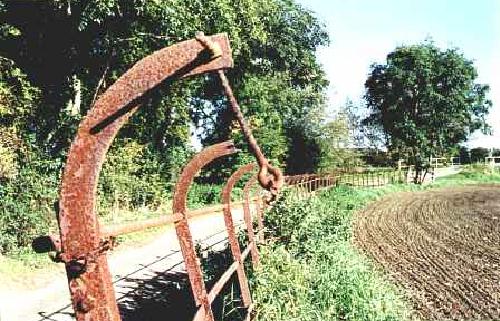|
Cheshire
rails
Iron rails at the field's edge in country areas are a familiar sight but few realise their significance or know of their origins.
They are known as Cheshire rails and were introduced in that county in the early
years of the 20th century and are still a distinctive feature through the area. They were once painted black and white, although many sections are now rusting and deteriorating, and conservationists
have repeatedly called for their restoration. There are also many miles of them in other parts of the country, including this part of Lincolnshire, although not always of the same design, but most sections are also falling into disrepair.
These iron fences were originally the idea of a Cheshire county councillor who in 1929 urged their introduction to improve visibility around bends and at junctions where the traditional hedges blocked the view for drivers at critical points in the road system at a time when the motor car was becoming more popular. The rails enabled road users see oncoming traffic through them and so take the necessary care to avoid an accident.
The rails, also known as hurdle fences, became a distinctive feature in the countryside and have proved their worth over the years but are now fast disappearing and many were dismantled during the Second World War in the search for metal to build munitions but were in fact never used and lay rusting in scrap yards long after the cessation of hostilities.
The biggest drive for conservation is in Cheshire itself where there were once
more than 120 miles of these rails around the edges of fields but they have not
been maintained and have now been reduced to less than 80 miles although
volunteers are busy spending time cleaning and painting what is left to ensure
their perpetuity.

Cheshire rails on a bend in the road at Braceborough village.
The best examples of Cheshire rails in this area are at Braceborough, four miles south of Bourne, where there are bends on approach roads at either end of the village. They are however rusting and leaning badly and mostly overgrown with clumps of tall nettles and other vegetation which makes their original purpose of improving visibility for drivers quite useless.
South Kesteven District Council carried out a survey of street furniture during
1999 and I sent them this suggestion in the hope that these rails and others in
the locality might be added to their list and that they would be given a lick of
paint to ensure their survival as a feature of our countryside but nothing has
yet been done. WRITTEN IN JANUARY 2000

Go to:
Main Index Villages
Index
|
